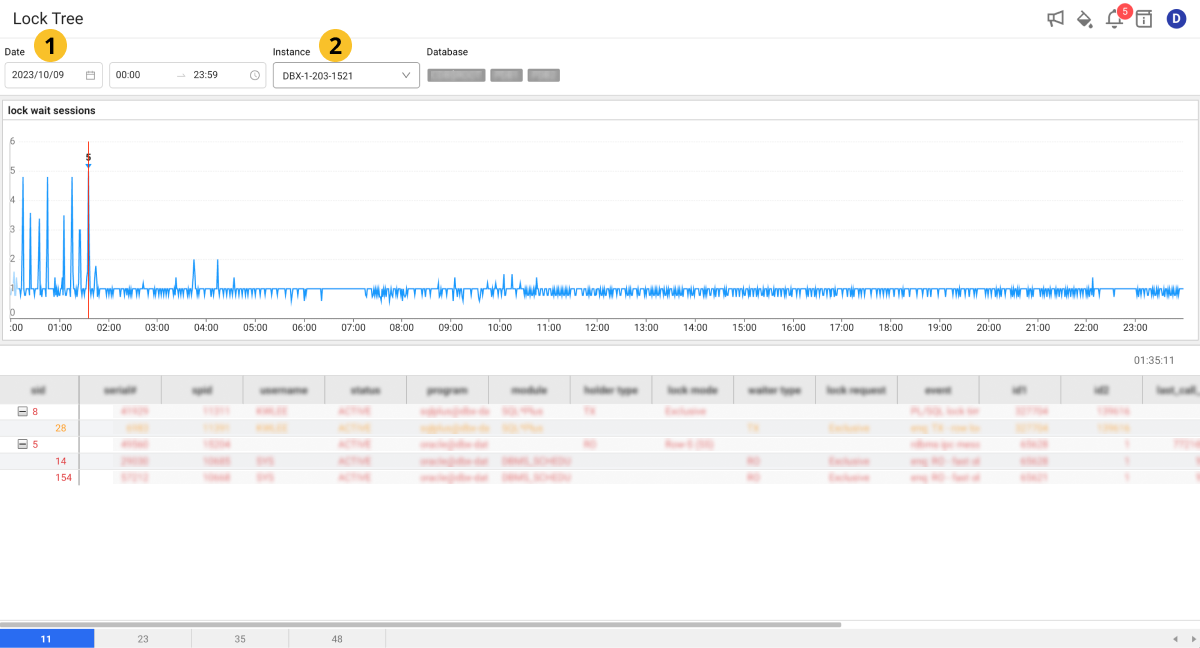Lock tree
Home > Select Project > Analysis > Lock Tree
This tool analyzes the trend of locks that occurred during the day. This function allows you to visually check the tree structure of the session that generated the lock (lock holder) and the session waiting for the lock (lock waiter). You can analyze the relationship between the holder and waiter of the lock that occurred at a specific time point.
Key features are as follows:
-
Lock trend analysis: The trends of locks that occurred during the set search period are traced over time and displayed in a graph. This allows you to visually check how the locks are created and resolved.
-
Check lock holder and waiter: You can see the holder and waiter for each lock in a tree structure. Through this, when a specific lock occurs, you can check the relationship between the session that generated the lock and the waiting session.
-
Inter-session relationship analysis: By analyzing the relationship between the session that generated the lock and the waiting session, you can identify the cause of the lock that occurred during the query execution and transaction handling.
This allows the database administrator to quickly identify and resolve lock-related issues and optimize the database performance.
Basic usage guide

Set the desired date and time, and then select an instance from the
list. If a lock occurs at the set time, lock wait sessions and the retrieved data appear in the table at the bottom of the screen.
-
Select the date to view and set the time in Time at the top of the screen.
-
Select an instance to monitor.
You can check the lock that occurred during the set time on the selected instance.
If any lock occurs during the set period, you can analyze whether locks are concentrated in a specific time period or whether a specific session continuously causes locks in the Lock Wait Sessions graph and the table at the bottom.
You can see the data in 5-second increments by dragging within 3 hours on the chart. However, the data in 5-second increments can only be viewed within the most recent month. The data earlier than one month can only be viewed as 5-minute summary data. For example, you can drag (drill down) lock tree data from 40 days ago for the 5-minute summary data, but you cannot see 5-second data.
Column information guide
Details for each session are provided in the following columns:
| Item | Description |
|---|---|
event | Name of the waiting event. |
holder type | Type of the session that owns a lock. |
id1 | First identifier value. |
id2 | Second identifier value. |
lock mode | Lock mode requested or owned by the current session. |
lock request | Status of the lock requested by the session. |
module | Name of the running module. |
pid | PID of the database process. |
prev_sql_id | Unique ID of the previously executed SQL statement. |
prev_sql_param | Parameter of the previously executed SQL. |
prev_sql_text | Text of the previously executed SQL statement. |
prog_name | Name of the program running the session. |
serial# | Serial number that distinguishes repeated attempts for the same session. |
sid | Session ID that uniquely identifies the session. |
sql_et | SQL execution time. |
sql_id | Unique ID of the SQL statement being executed. |
sql_param | Parameters used to execute SQL. |
sql_text | Text of the SQL statement being executed. |
status | Status of the session. |
username | Name of the user running the session. |
waiter type | Type of the session waiting for a lock. |
WhaTap basically stores the client-related information.